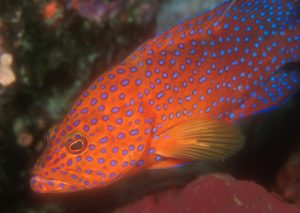 So at long last you’re setting up your dream marine fish tank, a nice large one – finally! That 40-gallon you’ve had for the past couple of years just isn’t cutting it. However, after saving up for the tank and all the other odds and ends that go with it, you’re still at a loss as to how to stock it. You want a knockout fish or two, but what fish will fill the bill? A common dilemma faced by most aquarists at one time or another, regardless of how large or small their new tank is. You want something striking, with a bit of size this time, and a scrap of personality. Oh, and last but not least, it should be hardy and easy to feed.
So at long last you’re setting up your dream marine fish tank, a nice large one – finally! That 40-gallon you’ve had for the past couple of years just isn’t cutting it. However, after saving up for the tank and all the other odds and ends that go with it, you’re still at a loss as to how to stock it. You want a knockout fish or two, but what fish will fill the bill? A common dilemma faced by most aquarists at one time or another, regardless of how large or small their new tank is. You want something striking, with a bit of size this time, and a scrap of personality. Oh, and last but not least, it should be hardy and easy to feed.
Well, I have just the fish for you – the hinds of the genus Cephalopholis. A beautiful assemblage of hardy aquarium fish that, when all factors are considered, is unrivaled in their suitability for the keeper who desires a larger display fish. A handful of species are commonly available, including the well-known Miniatus grouper, Cephalopholis miniatus, and the Argus, or Blue Dot Grouper, Cephalopholis argus. They are colorful, relatively placid, and intelligent fishes that have the capacity to win a keeper’s heart like few others. They are the closest thing to a marine “Oscar”, for those familiar with the personable freshwater fish favored by so many for its intellect and personality.
OK, what are they exactly?
They are beautiful, medium to large carnivorous fish with voluminous mouths that will eat anything too much smaller than they are! Want more? Here we go; they are often referred to as groupers, a term which is technically incorrect if you’re talking to a taxonomist working with the group. I should stop for a second, and say the family as a whole is a taxonomic mess, with a given genera or species falling into any number of different places, depending on who you’re listening to.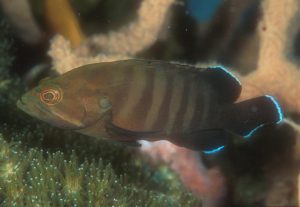
That being said, the family Serranidae, subfamily Epiphelinae, contains over a dozen genera, and the term grouper was, for a long time, a legitimate term used to describe any fish belonging to this subfamily. Recent taxonomic work on the group and the fallout accompanying it has suggested that the term “hind” be used when describing fish of the genus Cephalopholis, and the term “grouper” be reserved for fish of the genus Epinephelus. (Scott Michael, pers. comm.)
Taxonomists are forever clumping or separating (often undoing each other’s work in the process) organisms into different boxes, for better or for worse. Along with Cephalopholis, family Serranidae comprises many genera, with the term “Bass” being a generally accepted term for all of them.
You will find fish of the genus Cephalopholis referred to as groupers, bass, and cod in various publications. I dislike the term bass – while technically correct for this genus, as well as any fish of the family to which the genus belongs, it has also become a very nonspecific term for a huge variety of fish, both freshwater and marine. Show up at your local fish store, ask for a saltwater bass, and watch the store employee’s eyes glaze over. For my part, while I prefer, and will continue to use the term grouper to describe these fish in my daily communication with fellow hobbyists, for the purposes of this article I will stick with the “official” term, just for the sake falling in line with the current nomenclature.
In English Please!
These fish are robust, somewhat elongate marine predators that specialize in ambush tactics when hunting. If one examines fish that use this technique, he will find it usually means one thing – speed! Hinds are no exception, and it’s their swiftness that brings home the bacon, (or damselfish). Their mouths are capable of accommodating surprisingly large prey items relative to their own size. While their capacity in this regard falls a bit short of what I’ve seen certain true groupers of the genus Epinephelus accomplish, their abilities in this area should nevertheless not be underestimated. They are out and out predators, and anything 1/3 of their size or less is fair game.
Ok, I want one! (Maybe two) What else do I need do know?
The Tank
The first thing that the prospective hind-keeper needs to consider is housing. While these fish are considered small in the world of Sea Bass, they are still rather large for aquarium fish. While there are a few representatives of the genus that remain quite small, (in the 9” range), most species you are likely to encounter attain a length of at least 12”, if not longer. Also, as stated, they are robust fish that are not lacking in the girth department, either. What this means is that a 14” hind represents a considerably larger fish, and therefore more strain in the filtration system, than say a 14” wrasse.
For the smaller species, such as the Leopard Hind, Cephalopholis leorrada, or the V-tail hind, Cephalopholis urodeta, we can utilize a tank in the 75-gallon range for a single specimen. Of course, bigger is better, but consider this size your minimum. For the rest of the group, we’re looking at tank sizes 100 gallons and larger. Perhaps the most common species offered for sale, and arguably the most beautiful, is the Coral hind, (most often offered as the Miniatus grouper), Cephalopholis
miniatus. This is a fish that attains a size of 16” in the wild, and while captive specimens are smaller, they can be expected to reach no less than 13”or so in the aquarium. Large tanks are needed for a hind of this size, especially if the aquarist intends to keep a few other fish along with it. I recommend a 180 gallon tank at minimum if considering a larger hind species or two, accompanied by a few suitable tank mates.
The tank should also contain rock-work or other decor arranged in such a way as to create shelters, as well as visual barriers. These fish are quite territorial, and while they pose little threat to fish of other genera that are too large to swallow, they can initially be quite aggressive towards other members of the genus (and sometimes other larger Serranids as well). To a large extent, out of sight is out of mind, so providing visual barriers will help minimize aggressive interactions. They are particularly fond of caves and overhangs, so provide one or two such areas for your fish. I had a Miniatus some years ago that was very fond of a large, empty giant clam shell, propped open as to permit access. This site was his “home base”, and he defended it vigorously.
Filtration
I’m not going to lie; watching these fish eat is FUN! Before I discontinued the use of live feeders some years ago, I often watched in amusement as a small feeder goldfish hit the water in a 135-gallon tank that housed a 10” Coral hind. What followed an instant later was literally a blinding red blur, and a small cloud of fish scales settling to the bottom of the tank where the goldfish had been. Then there was the ever-entertaining game of, “how large of a squid can my fish eat?” It stands to reason, however, that for every morsel of food introduced into a system, a corresponding amount of organic waste is produced. While not particularly messy eaters, they eat quite a large amount, even if one doesn’t “power feed”, or introduce food items at a greater than necessary frequency; an easy trap to fall into with these fascinating predators.
Regarding filtration, high turnover is the key, and several filters should almost always be operated. While live rock is fine, and should certainly be utilized, it’s not adequate to handle the waste output of our hind tank all by itself. On a 180-gallon display containing live rock, a large hind, and several other predators, two large outside power filters that are easily cleaned are a good choice, or a large capacity canister filter such as an Eheim or Fluval. These filters should be cleaned and rinsed regularly in order that they maintain effectiveness.
Selection
Next, assuming the tank is properly set up and established, and a quarantine tank of suitable size is also ready and waiting, you can start looking for your new pet fish. Hinds are resilient fish, and thankfully handle shipping well, so most specimens are in fine shape still by the time they reach your local store. Look for good color, and make sure there are no off color patches or spots on the skin or fins. Look for pits on the head, or behind the eyes, which could be indicative of lateral line erosion. Also, make sure the fish is alert, and wary. A healthy individual is attentive, and will look back at you in a way you don’t experience from most other marine fish. The aquarist doesn’t have to be too concerned about the size of the individual he’s shopping for, as both very young and larger more mature individuals adapt readily to captivity. I do recommend, however, that a fish no larger than 6” be purchased, as this allows the hind to “grow in” to his environment. Although they may reach a given size in the wild, most remain somewhat smaller in home aquaria, depending on the size of the tank. Having said this, expect at least a 12 to 14” fish with C. miniata or C. argus, and at least a 10” fish with medium sized species such as C. formosa (blue line).
Introduction
When introducing a hind into your display (you did quarantine him, didn’t you?), it’s a good idea, if practical, to rearrange the décor in order to break up existing territories in the tank. This is especially true if any somewhat aggressive fish are already established in the system, such as an angelfish for instance. These fish are often very shy at first, often dashing into a cave or crevice, the keeper seeing only glimpses of it for a number of days. Over time, they become bolder, spending more and more time in full view.
Contrary to what you may read elsewhere, if the tank is in the previously stated 180-gallon range, it’s very possible to keep two or more hinds of different species together in a single display. The most preferred method for accomplishing this is to add the fish at the same time. This way the fish in question are on equal footing, neither having an established territory, and both are somewhat disoriented at suddenly finding themselves in new surroundings. Again, rearranging the décor will be of help here. If a hind is already established in the system, it is almost imperative that the newcomer bit a bit larger than the resident. The established fish will invariably be irritated at the new arrival in his territory, and will hold the upper hand in the inevitable confrontation. If the newcomer is somewhat larger, he will be less stressed by, and better able to cope with the irate displays and gapping of the resident hind. This displaying, gapping, chasing and ritualized combat starts out rather intensely by both individuals, and decreases in frequency and severity over a matter of hours. By the next day, both fish are normally over it, and life can proceed as normal.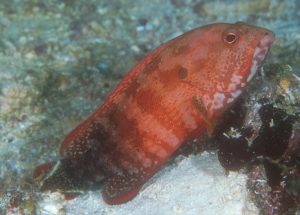
What do they eat?
What don’t they eat? Well, as stated, they are predators in full, exclusively and unrepentantly carnivorous – leave the nori and green flake in the cabinet. Lately, live freshwater food items such as goldfish are frowned upon for nutritional reasons.Certain maladies and deficiencies have been linked to the frequent feeding of freshwater food items, and most especially, goldfish. The mere possibility of health issues, along with the expense and hassle of dealing with feeders has prompted most keepers of marine predators to discontinue their use.
There is also a school of thought out there that feeding live fish to a predator makes the fish more aggressive. Well, I can without reservation tell you that such assertions are utter nonsense. Feeding behavior has absolutely nothing to do with the presence or absence of territorial aggression in fish. These fish have evolved over millions of years, and have been piscivores all the while. They didn’t forget just because a keeper has neglected to offer a live prey item, nor does the introduction of live prey items suddenly trigger a previously suppressed aggressive propensity. Having said this, the above-mentioned concerns regarding goldfish should nevertheless heeded without reservation.
Where does that leave you? With a plethora of choices, thankfully. A visit to the seafood counter at your local grocer will reveal a multitude of choices. Of particular use are scallops, shrimp and squid, as they are for most hinds, already in ready-to-feed, bite size morsels. Fish meat such as halibut and snapper can also be utilized. It should be noted, however, that all predators, be they reptiles, birds, cats or fish, need WHOLE food items in order to obtain all the nutrients they require, not just meat. In other words, organs, bone, etc. are all part of their natural diet. This means the keeper must offer some kind of complete animal item at least once or twice a week, and these items should be as varied as possible. Possibilities are; frozen baitfish of various species, which are often available at bait stores, or whole shrimp and crayfish. Frozen silversides are commonly available at aquarium fish retailers as well. All food items should be soaked in Selcon – or similar vitamin supplement a few times a week. Additionally, there are frozen preparations available that are vitamin fortified, and make excellent food for these fish.
What else can I keep with it?
Hinds are rather easygoing fish for the most part. Although aggression among conspecifics is intense to the point where keeping two of a given species is usually impossible, interspecific aggression is usually minimal, especially where other non-serranids are concerned. The main concern the aquarist has is selecting companions that are too large to be swallowed by the hind. While they often will defend with much fervor a favorite hole, cave or overhang, these defensive measures usually amount to nothing more than gapping, and other dramatic displays that amount to little, especially if ignored by the other fish. Indeed, more belligerent companions can easily victimize hinds if some basic guidelines are not followed.
I’ve already bucked common opinion just a bit, and announced that keeping more than one hind to a tank is possible, I should emphasize that is based on empirical data, and not just conjecture on the part of the author. Again, while the initial reaction by one or both individuals is intense, it normally subsides over a period of time. Furthermore, there are other “true” groupers that can be kept with a hind. A particularly suitable species that comes to mind is Epinephelus ongus, the spotted or specklefin grouper. This fish is a “true grouper” in good standing, and one of the best choices for the home aquarium. It’s attractive, hardy, bold, and only attains a maximum size of 11” or so in the wild, with captive specimens maybe reaching 9” or so on average. Epinephelus merra, and Epinephelus hexagonatus are also smaller members of the genus that make first-rate choices, although available with much less frequency than the specklefin.
Large angels are a fine choice for the more experienced aquarist, but be wary of very aggressive species such as those in the Holocanthus genus. The main offenders that come to mind are the Queen and Passer angels. Hardy, attractive, and easy to feed, they are also very aggressive and can intimidate a hind to the point where the keeper may seldom see it. Much better choices are the Emperor angel, Pomacanthus imperator, the Koran angel, P. semicirculatus, or the Half moon angel, P.
maculosus, with the latter being the hardiest of the three. Since angels are rather tall in body shape, it’s a simple matter to purchase one that is too large for the hind in consider a meal.
Triggerfish make fine tank mates, but the aquarist should steer away from the larger, more aggressive species such as the clown trigger, undulated trigger, or the blue line and queen trigger. Triggers of the genus Rhinecanthus make acceptable additions, and several members of the group can even be kept in the same tank so long as they are added at the same time. The huma huma trigger, Rhinecanthus aculeatus is by far the most popular representative of the genus, and mixes well with hinds and groupers so long as he’s large enough to avoid being swallowed.
Tangs and surgeonfishes are another group of fishes that represent a good tank mate choice for your hind. The only caveat perhaps being that the aquarist should steer away from the powder blue, and powder brown surgeons, as they are fragile and problematic. Naso tangs, Naso lituratus, and most members of the Zebrasoma genus, including the yellow tang, Zebrasoma flavescens are excellent choices.
Lionfish, a favorite among marine aquarists are another good choice. Obviously, a very large lionfish should not be mixed with a very small hind, and vise versa, but as long they are within the same size range, they make good companions.
Moray eels often find their way into a mixed predator tank, as well they should – you just can’t kill a moray eel! They are retiring, non-territorial, hardy and generally easy to feed. The Snowflake moray, Echidna nebulosa, and the Dragon moray, Enchelycore pardalis, are just two of the choices available. Although many morays are piscivores, as long as the keeper keeps in mind the head size of the eel, and selects the hinds and other tank mates accordingly, there shouldn’t be any problems. Any hind in the 6” range or bigger is too large for any but the largest moray to consider ingesting in any case, so unless you just couldn’t resist that 4-foot tesselata moray at the store, no worries!
Yet another group of fish with no shortage of suitable options are the wrasses. The dragon wrasse, Novaculichthys taeniourus, larger hogfishes of the genus Bodanius, such as the Spanish hogfish, Bodanius rufus, the harlequin tuskfish, Choeredon fasciatus and the bird wrasse, Gomphosus varius are all superb choices in a tank containing one or more hinds. The larger Coris species are also excellent choices.
In Closing
So what are you waiting for? Get that tank going and go get yourself a hind or two! I can’t imagine a large marine predator tank without one. If you’re looking for that centerpiece fish, and by golly it had better be hardy, have stunning good looks, be a cinch to feed as well as fairly easy going, then look no further than the genus Cephalopholis.


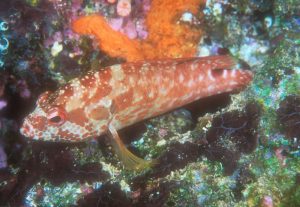
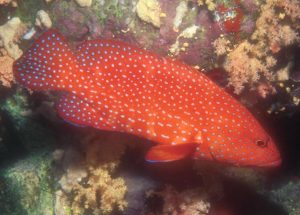

0 Comments